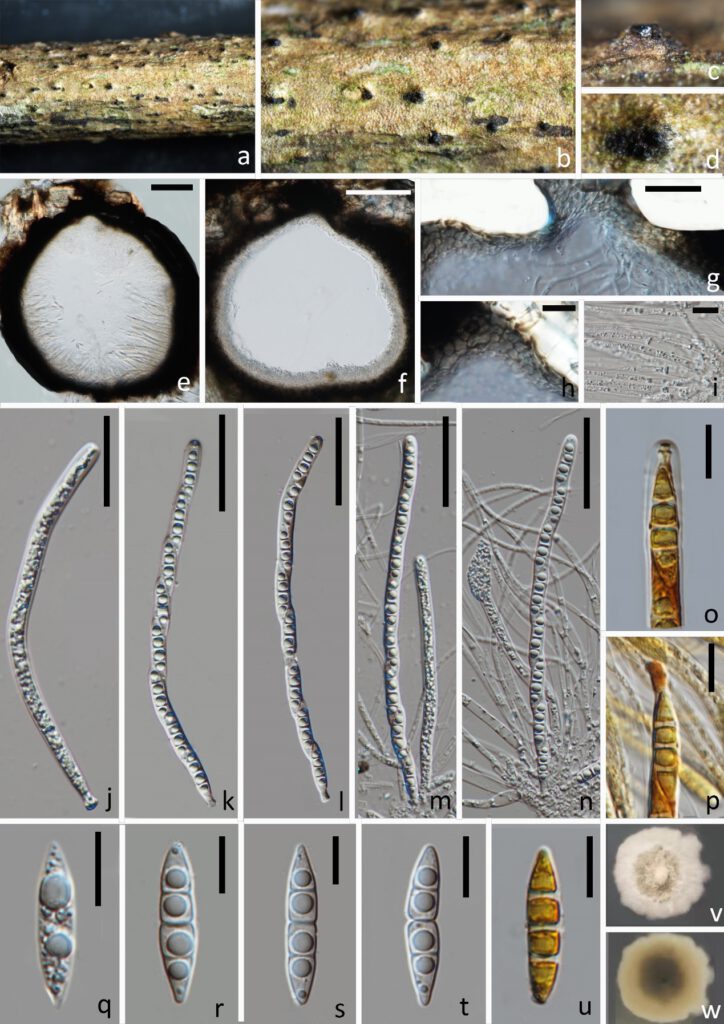Melomastia winteri W.L. Li, Maharachch. & Jian K. Liu, sp. nov Figure 5
MycoBank number: MB 841502; Index Fungorum number: IF 841502; Facesoffungi number: FoF 10536;
Etymology: The epithet “winteri” refers to the season where the type species was collected
Holotype: HKAS 121314
Saprobic on dead branches of Olea europaea. Sexual morph Ascomata 340–365 × 364–410 μm ( = 352 × 387 μm, n = 15), solitary, gregarious, semi-immersed to immersed, globose to subglobose, coriaceous to carbonaceous, dark brown to black, ostiolate. Ostioles 105–108 × 106–113 μm ( = 106.5 × 109.5 μm, n = 10), central, coriaceous to carbonaceous, dark brown to black, papillate, periphyses filling the ostiolar canal. Peridium 55–62.5 μm ( = 59 μm, n =10) wide, with two strata, outer thick, carbonaceous and inner composed of 3–4 layers of hyaline to lightly brown cells of textura angularis to textura prismatica. Hamathecium composed of numerous, 1.5–3.5 μm wide, dense, filiform, unbranched, septate, cellular pseudoparaphyses. Asci 165–189 × 7–8.5 μm ( = 177 × 7.5 μm, n = 30), 8-spored, bitunicate, cylindrical, slightly flexuous, apically round, with a distinct ocular chamber, cylindrical pedicellate 4.8–6.5 × 3.5–4.6 μm ( = 5.6 × 4 μm, n = 30). Ascospores 25–30 × 5–6.5 μm ( = 27.5 × 6 μm, n = 30), uniseriate, partially overlapping, fusiform with acute ends, hyaline, 3-septate, deeply constricted at the median septum, with guttules in each cell, lacking a mucilaginous sheath. Asexual morph: Undetermined.
Culture characteristics: Colonies on PDA reaching 30 mm diam. after 4 weeks at 25 °C. Cultures from above, white, dense, circular, margin erose, umbonate, papillate with somewhat fluffy, pale orange at the center; reverse dark brown at the center, pale yellow at the edge.
Material examined: China, Sichuan Province, Chengdu City, Shuangliu District, Olive Base, 30°33.25′N, 103°99.62′E, at an altitude of 432 m (the foot of the mountain), 29 January 2021, W.L. Li, Z.P. Liu, T. Zhang, GL 010 (HKAS 121314, holotype; HUEST 21.0009, isotype); extype living culture CGMCC3.20621 = UESTCC 21.0009.
GenBank numbers –LSU, ITS, SSU, TEF, RPB2
Notes: Phylogenetic analysis showed that Melomastia winteri clustered with M. fusispora (97% ML BS, 100% MP BS, 1.00 BI). Morphologically, M. winteri is similar to M. fusispora in having 3-septate fusiform ascospore. However, M. fusispora can be distinguished from M. winteri by its larger ascomata (432–624 × 527–618 µm vs. 340–365 × 364–410 μm) and longer asci (200–231 µm vs. 165–189 µm). Additionally, M. fusispora has a thin gelatinous sheath around the ascospores, which is not observed in M. winteri.

Figure 4. Melomastia winteri (HKAS 121314, holotype). (a–d) Ascomata on the subtrate. (e, f) Vertical of the ascoma. (g) Vertical section of the ostiole. (h) Peridium. (i) Paraphyses. (j–n) Asci. (o) Ocular chamber in Lugol’s lodine. (p) Pedicel in Lugol’s lodine. (q–u) Ascospora (u in Lugol’s lodine). (v) Upper view of the colony after 14d. (w) Reverse view of the colony after 14d. Scale bars: e, f = 100 μm, g, h, i, o–u = 10 μm, j–n = 40 μm.
